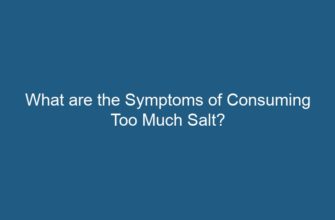Redness in the lower legs can be a common symptom that many people experience at some point in their lives. It can be caused by various factors, including medical conditions, lifestyle choices, and external factors. In this article, we will explore the different causes of redness in the lower legs, discussing each subtopic in detail.
- 1. Poor Circulation
- 2. Inflammatory Skin Conditions
- 3. Infections
- 4. Allergic Reactions
- 5. Dermatitis and Eczema
- 6. Venous Insufficiency
- 7. Sunburn
- 8. Medications
- FAQs
- 1. Can poor circulation cause redness in one leg only?
- 2. How can I relieve redness and itching in my lower legs?
- 3. When should I seek medical attention for redness in my lower legs?
- 4. Can stress cause redness in the lower legs?
- 5. Are there any natural remedies to reduce redness in the lower legs?
- 6. Can a sedentary lifestyle contribute to redness in the lower legs?
- Conclusion
1. Poor Circulation
Poor circulation is one of the primary causes of redness in the lower legs. When blood flow to the legs is compromised, it can result in a variety of symptoms, including redness. Conditions such as peripheral artery disease (PAD), deep vein thrombosis (DVT), and varicose veins can all contribute to poor circulation and subsequent redness.
Peripheral artery disease occurs when the arteries that supply blood to the legs become narrowed or blocked due to a buildup of plaque. This restricts blood flow and can lead to redness, as well as other symptoms like leg pain and cramping.
Deep vein thrombosis is a condition in which blood clots form in the deep veins of the legs. This can impede blood flow and cause redness, swelling, and pain in the affected area.
Varicose veins are enlarged, twisted veins that often appear on the legs and can be a result of weakened vein valves. They can cause redness and aching in the legs, as well as other symptoms such as swelling and skin discoloration.
2. Inflammatory Skin Conditions
Another common cause of redness in the lower legs is inflammatory skin conditions. These conditions can cause irritation and redness due to inflammation of the skin. Some examples include:
- Atopic dermatitis: Also known as eczema, this condition is characterized by dry, itchy, and inflamed skin. It can cause redness in the lower legs if the skin in that area is affected.
- Psoriasis: Psoriasis is a chronic autoimmune condition that speeds up the growth cycle of skin cells. It can result in red, scaly patches on the skin, including the lower legs.
- Contact dermatitis: This type of dermatitis occurs when the skin comes into contact with an irritant or allergen. It can cause redness, itching, and a rash on the lower legs.
3. Infections
Infections can also lead to redness in the lower legs. Bacterial and fungal infections are the most common culprits. Here are a few examples:
- Cellulitis: Cellulitis is a bacterial skin infection that can cause redness, swelling, and warmth in the affected area. It can occur on the lower legs and may be accompanied by fever and pain.
- Athlete’s foot: This fungal infection primarily affects the feet but can spread to the lower legs. It causes redness, itching, and peeling of the skin.
- Erysipelas: Erysipelas is a bacterial infection that typically affects the legs and face. It causes redness, swelling, and pain in the affected area.
4. Allergic Reactions
Allergic reactions can manifest as redness in the lower legs. When the body comes into contact with an allergen, such as certain medications, foods, or environmental triggers, it can trigger an immune response that results in redness and other symptoms. Contact with irritants like poison ivy or certain chemicals can also cause redness as an allergic reaction.
5. Dermatitis and Eczema
Dermatitis and eczema can both cause redness in the lower legs. Dermatitis refers to inflammation of the skin, while eczema is a specific type of dermatitis characterized by dry, itchy, and inflamed skin. Both conditions can result from various factors, including allergies, irritants, and genetic predisposition.
When the skin on the lower legs is affected by dermatitis or eczema, it can become red, inflamed, and itchy. Scratching the affected area can worsen the symptoms and lead to further redness.
6. Venous Insufficiency
Venous insufficiency occurs when the veins in the legs are unable to adequately return blood to the heart. This can result in pooling of blood in the lower legs, leading to redness, swelling, and other symptoms. Venous insufficiency can be caused by factors such as obesity, sedentary lifestyle, pregnancy, and a family history of the condition.
7. Sunburn
Excessive sun exposure without proper protection can cause sunburn on the lower legs, resulting in redness, pain, and peeling of the skin. Sunburn occurs when the skin is damaged by ultraviolet (UV) radiation from the sun. It is important to apply sunscreen and wear protective clothing to prevent sunburn and reduce the risk of redness in the lower legs.
8. Medications
Certain medications can cause redness in the lower legs as a side effect. Some types of medication that have been associated with this symptom include:
- Blood pressure medications: Some blood pressure medications, such as calcium channel blockers, can cause peripheral edema, which may lead to redness in the lower legs.
- Antibiotics: Certain antibiotics, such as penicillin and sulfa drugs, can cause allergic reactions that result in redness and rash.
- Nonsteroidal anti-inflammatory drugs (NSAIDs): Prolonged use of NSAIDs can sometimes cause skin reactions, including redness, hives, and rashes.
FAQs
1. Can poor circulation cause redness in one leg only?
Yes, poor circulation can cause redness in one leg only. Conditions like peripheral artery disease or deep vein thrombosis can affect one leg more severely than the other, leading to localized redness.
2. How can I relieve redness and itching in my lower legs?
To relieve redness and itching in the lower legs, you can try the following:
- Apply a cold compress to reduce inflammation.
- Use over-the-counter hydrocortisone creams to alleviate itching.
- Keep the affected area clean and dry.
- Elevate your legs to promote better circulation.
- Avoid scratching the affected area to prevent further irritation.
3. When should I seek medical attention for redness in my lower legs?
You should seek medical attention for redness in your lower legs if:
- The redness is accompanied by severe pain or swelling.
- You have a fever.
- The redness does not improve or worsens over time.
- You have a history of blood clotting disorders.
4. Can stress cause redness in the lower legs?
While stress itself may not directly cause redness in the lower legs, it can exacerbate certain underlying conditions that may result in redness, such as eczema or psoriasis.
5. Are there any natural remedies to reduce redness in the lower legs?
Some natural remedies that may help reduce redness in the lower legs include:
- Applying aloe vera gel to soothe the skin.
- Using chamomile tea compresses to reduce inflammation.
- Applying apple cider vinegar diluted with water to relieve itching.
- Taking oatmeal baths to soothe irritated skin.
6. Can a sedentary lifestyle contribute to redness in the lower legs?
Yes, a sedentary lifestyle can contribute to redness in the lower legs. Lack of physical activity can impair circulation and lead to conditions like venous insufficiency, which can cause redness in the legs.
Conclusion
Redness in the lower legs can be caused by various factors, including poor circulation, inflammatory skin conditions, infections, allergic reactions, dermatitis and eczema, venous insufficiency, sunburn, and certain medications. It is important to identify the underlying cause of the redness to determine the appropriate treatment. If you experience persistent or severe redness in your lower legs, it is advisable to consult a healthcare professional for a thorough evaluation.










